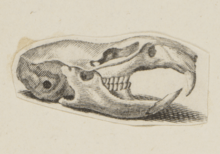Narrow-headed vole
The narrow-headed vole (Microtus gregalis) is a species of rodent in the family Cricetidae.[2] Ranging over northern and central Asia and also into Alaska, it is the only species in the subgenus Stenocranius.
| Narrow-headed vole | |
|---|---|
 | |
| Microtus gregalis - skull and snout | |
| Scientific classification | |
| Kingdom: | Animalia |
| Phylum: | Chordata |
| Class: | Mammalia |
| Order: | Rodentia |
| Family: | Cricetidae |
| Subfamily: | Arvicolinae |
| Genus: | Microtus |
| Subgenus: | Stenocranius Katschenko, 1901 |
| Species: | M. gregalis |
| Binomial name | |
| Microtus gregalis (Pallas, 1779) | |
Description
The narrow-headed vole has a head-and-body length between 89 and 122 mm (3.5 and 4.8 in) and a short tail of 21 to 32 mm (0.8 to 1.3 in). The dimensions of the skull distinguishes it from other Microtus species in China. In summer, the fur on the back is pale yellowish-buff, paler on the flanks and merging into the yellowish-grey underparts. In winter, the dorsal colour is a brighter reddish-ochre. The tail can either be a uniform yellowish-buff or can be bicoloured, dark brown above and yellowish-brown below. The upper surfaces of the hands and feet are brownish-white. [3]
Distribution and habitat
The narrow-headed vole is distributed across the tundra region of northern Europe and Asia from the White Sea to the Kolyma River. It also occurs as separate populations on the steppes of Kazakhstan, Kyrgyzstan, southwestern Siberia, the Sakha Republic, Mongolia and northern China. It is also found in Alaska. Its typical habitat is grassy plains, semi-deserts, open grassy areas in forests, alpine meadows and water meadows at altitudes of up to 4,000 metres (13,000 ft).[1]
Behaviour
The narrow-headed vole lives in a complex system of tunnels that run up to 25 cm (10 in) beneath the ground surface. This has multiple entrances and several nesting chambers. The narrow head of this species may have evolved to make it easier for it to squeeze through narrow gaps and crevices in frozen ground.[3] It is mainly active at dusk and by night, but also emerges from its burrow to forage during the day. It feeds on grasses, legumes and other underground and above-ground plant material. Breeding takes place in the warmer months, with about five litters averaging eight offspring being produced annually.[3]
Status
The narrow-headed vole has a very extensive range and although populations fluctuate, no particular threats have been identified with this species and overall the population seems stable. The International Union for Conservation of Nature has assessed its conservation status as being of "least concern".[1]
References
- Batsaikhan, N.; Tsytsulina, K.; Formozov, N.; Sheftel, B. (2008). "Microtus gregalis". IUCN Red List of Threatened Species. 2008. Retrieved 10 October 2014.CS1 maint: ref=harv (link)
- Musser, G.G.; Carleton, M.D. (2005). "Superfamily Muroidea". In Wilson, D.E.; Reeder, D.M (eds.). Mammal Species of the World: A Taxonomic and Geographic Reference (3rd ed.). Johns Hopkins University Press. pp. 998–999. ISBN 978-0-8018-8221-0. OCLC 62265494.
- Andrew T. Smith; Yan Xie (2008). A guide to the mammals of China. Princeton University Press. p. 231. ISBN 978-0-691-09984-2.
4) Lissovsky, A.A. Morphological and genetic variation of narrow-headed voles Lasiopodomys gregalis from South-East Transbaikalia / A.A. Lissovsky, E.V. Obolenskaya, T.V. Petrova // Russian Journal of Theriology. – 2013. – Vol. 12. – P. 83–90.
5) Petrova, T.V. Phylogeography of the narrow-headed vole Lasiopodomys (Stenocranius) gregalis (Cricetidae, Rodentia) inferred from mitochondrial cytochrome b sequences: an echo of Pleistocene prosperity / T.V. Petrova, E.S. Zakharov, R. Samiya, N.I. Abramson // Journal of Zoological Systematics and Evolutionary Research. – 2015. – Vol. 53, no. 2. – P. 97–108.
6) Petrova, T.V. Cryptic speciation in the narrow-headed vole Lasiopodomys (Stenocranius) gregalis (Rodentia: Cricetidae) / T.V. Petrova, A.S. Tesakov, Y M. Kowalskaya, N.I. Abramson // Zoologica Scripta. – 2016. – Vol. 45, no. 6. – P. 618–629.
